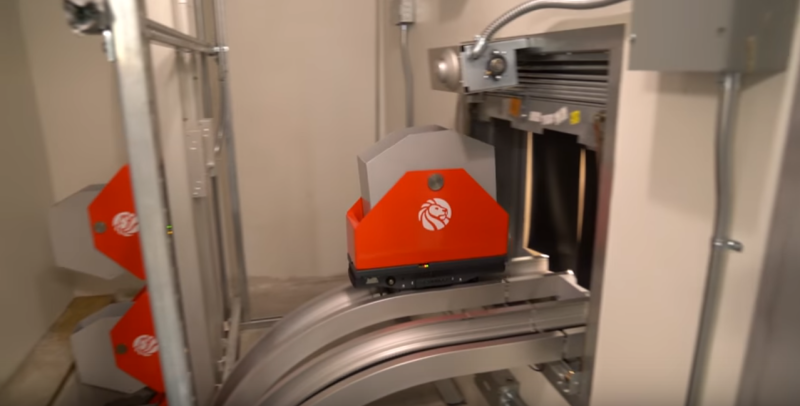What’s the best way to quickly move books from a vast underground archive to the library patrons who want to read them? For the New York Public Library (NYPL), it used to be an elaborate conveyor belt system. But the trouble with those is that the books will fall right off of them on a vertical run. What the NYPL’s gargantuan flagship library on 5th Avenue needed was a train to shuttle the books around. This week, as the majestic Rose Main Reading Room reopens after renovation, the train will leave the station.
From January to August 2016, workers retrofitted the existing conveyor belt infrastructure to support 950 feet of shiny, winding track. ‘Train’ is a bit of a misnomer because the cars travel singly. The double-track system traverses eight floors of library from the underground archive to any of the 11 designated stops. There are 24 book cars at present. Each one can hold about 30 pounds of books and travels at about 75 feet per minute.
In order to move between floors economically, some sections of track are completely vertical. How do the books stay in there? Simple—the cargo hold pivots on a gimbal. Sensors along the track make it easy to keep tabs on the cars, which are separated by a 15-second buffer to avoid collisions and mishaps. Click past the break for a sped-up demonstration. For you purists out there, we’ve also embedded the full, silent, real-time version that clocks in at nearly five minutes.
We like all kinds of trains around here, from the subterranean to the scientifically derailed.
https://www.youtube.com/watch?v=xdi9LiRt8JE
The full version:
Image credit: Jonathan Blanc/New York Public Library
[via Web Urbanist]















I miss that library. Spent quite a bit of time there in the early ‘aughts.
I hope they trim out the tracks in the room, that track system clashes with all that lovely wood.
Anyone got a video of the old system?
https://youtu.be/4hU_gQfQY1w?t=34
Anck-Su-Namun!
Supposedly a librarian still has to go find the correct book and stick it in a train car, It seems really silly to go through all that effort on a transportation system and not also try to automate archival and retrieval of the books. There are several vendors on the market that do fully automated warehouses, I’m sure at least some of those solutions would work on books as well.
Although I wonder if in this modern age of print-on-demand if it would be cheaper overall to just run a tiny library where the books are digital and it spits out a freshly printed paper copy whenever someone wants to read it. You could cache the most popular books in paper form and once the interest dies down you could auction them off or something, with profits going to the author :)
The print on demand is an interesting idea but with the economies of scale, especially for colour printing, I think that printing thousands of copies at a time will remain the cheapest method of publishing for the near future.
At this stage, it’d be very difficult to get the publishers on board with that idea…they want us to buy expensive hard copies or tens of thousands a year for subscriptions to their archives. Not to mention, copyright laws limit us to at most a chapter for scan/copy/email.
There is an automated system at the Grand Valley State Steelcase library in Grand Rapids MI that is kind of cool too: https://www.youtube.com/watch?v=814-3dxQ5bY
I think that gets around the librarian needing to go manually find the book
As the other comment says, every print would incur a full-size royalty to the author at time of printing.
Take a look, it’s in a book. READING RAILROAAAAADDD
+1
Wow – at 1:20 in the full (second) video those look like some fairly tight tolerances.
This is supposed to be in a library?
There wasn’t a book in sight, even the shelves were bare!
how long does it take to get a book delivered to you?
4 minutes.
The shelves are in the Rose Main Reading Room. They are empty because this was shot sometime during the renovation.
and here I thought Reading Railroad was swallowed up by CSX Transportation.
https://s-media-cache-ak0.pinimg.com/originals/d7/6c/5c/d76c5c992cbb527186f13567003d5bbc.jpg
Am I the only one that loves the little wiggle-waggle it does when the trains come to a stop?
Mayo Clinic Rochester (Minnesota) has several differnet “train” systems for delivering drugs from the pharmacy to various nurses stations, and for transporting lab samples to the labs.
^different^
Ren, you beat my to it. Mayo’s ETV system (electric track vehicle system) is quite impressive. This book system looks pretty similar only real difference being the carrier. Mayo’s pneumatic tube system is also pretty impressive. Keep your head down when crawling through the pass ways in Gonda’s sub basement when the ETV comes rolling through, they tend not to care who or what is in the way. The tube system can be a little creepy when walking through the utility tunnels as those things go flying past you with a little chug chug at every pipe joint it hits.
They just need a sushi chef in part of the library now
A similar system exists since 1998 at the BNF (Bibliothèque Nationale de France = National French Library) in Paris:
http://www.youtube.com/watch?v=WMh-UTW1tgw
The company who makes this system, TeleDynamics, has been making them for over twenty years.